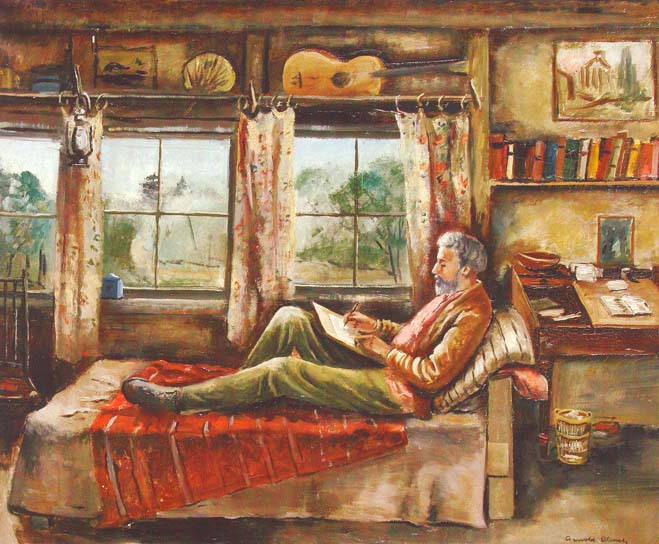
A painting of Hervey White by Arnold Blanch
Hervey White was a storied hippie in the early 1900s. His novels were praised by Theodore Dreiser, and he hobnobbed at Jane Addams’s Hull House with such other progressive intellectuals as Clarence Darrow, Sidney Webb, and Ramsay MacDonald. It was there that he met Ralph Radcliffe Whitehead. The latter was a wealthy English commoner in search of his own personal utopia. With White and Bolton Brown, Whitehead set out for the East Coast to find his Shangri-la. They soon fetched up in Woodstock, NY. Together the trio co-founded the Byrdcliffe Arts and Crafts Colony, which still thrives under the stewardship of the Woodstock Byrcliffe Guild.
White grew tired of Whitehead’s ways and purchased a 100-acre farm just over the Woodstock town line. He called his patch the Maverick after an untamed horse. Soon several primitive cabins were built, and artists began moving in. White was used to roughing it. He had been born in a sod hut and accumulated savings for his Kansas State University education by working as a cook for his father’s farm workers and doing odd jobs. In 1894, he graduated from Harvard and booked passage in steerage, crossing the Atlantic to Italy. There he traveled on foot and stayed in hostels and workers’ homes.
On the Maverick, Hervey set up a printing press in his home and cranked out a succession of publications like The Wild Hawk and The Plowshare. They were filled with his poems, plays, and essays, along with contributions from local wits and writers. By 1915 White’s colony faced a water crisis. Several of the artists suggested that Hervey stage a music festival to raise funds for an artesian well. This proved to be so successful that White promoted similar events through 1931. Upwards of 8,000 persons attended from one year to the next. These gatherings became so wild that they had to be closed down. Sadly, with their demise, a profitable source of funds for Hervey and his Maverick colony came to an end. White remained true to his untamed spirit, spending his last day in a hedge grove. It was there, one day in 1944, that a friend chanced to find Hervey in his final resting place.
According to Roots of the 1969 Woodstock Festival: The Backstory to “Woodstock,” a Hopi legend foretold a time when Native Americans would return to the world wearing long hair and adorned with flowers and beads. They would be known as hopis or hippies. Barry Miles, in his book titled Hippie, suggests that the beat generation incubated the hippie movement. He says that the movement grew up in reaction to the mind-numbing conformity unleashed by the World War II generation’s mirror-copy housing tracts, etc. The Beats may get the nod for popularizing the counterculture, but it was art colonies like Woodstock, NY, that gave birth to it. Later on, this connection was formalized when the worldwide phenomenon culminated in the Woodstock Festival of 1969.
~ Weston Blelock

Hi, I’m wondering if you know how to contact the current copyright owner of the Arnold Blanch painting you have on your post, as I wish to request permission to use it. Thank you 🙂